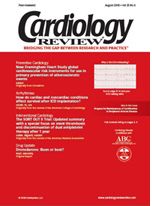Publication
Article
Cardiology Review® Online
Diabetics: The hard-hearted ones
Diabetes is bad. In addition to causing susceptibility to neuropathy, nephropathy, retinopathy, and other devastating end-organ complications, diabetes is a prime cause of vascular disease and its consequences
—stroke, myocardial infarction (MI), claudication, and cardiac death. Diabetes has recently been categorized by the National Cholesterol Education Program Guidelines as a “coronary disease equivalent” in recognition that diabetes confers the same risk of vascular events as a history of MI.* Diabetic patients are thus identified by these guidelines as targets for the more aggressive secondary prevention strategies, with lower target low-density lipoprotein cholesterol levels (< 100 mg/dL or optionally < 70 mg/dL) and systolic blood pressure (< 130 mm Hg) goals than patients without manifest vascular disease targeted for primary prevention.
It is well known, however, that some diabetic patients do well even in the absence of perfect glucose control, whereas others are “vasculopaths” even when scrupulously managed. It would be useful to better understand which diabetic patients have more vascular disease or vascular risk than others. The study by Ferramosca and colleagues (page 20) takes a novel approach to this question by examining diabetic patients who had coronary calcium scanning and 5 years of clinical follow-up. The main finding, that diabetic patients had higher calcium scores and thus more coronary disease and higher mortality than nondiabetic subjects, is hardly surprising. But more interesting is the finding that, for a given coronary calcium score, diabetic patients did worse than nondiabetic subjects by having higher death rates. More interesting still is the subset of diabetic patients who had no detectable coronary calcium. These patients did quite well, as well as nondiabetic subjects, and had 99% survival.
This study strongly suggests that a key cause of death among diabetic patients is vascular mortality, and this risk may be better estimated with the addition of the coronary calcium score to other clinical criteria (such as the Framingham index). Vascular disease appears to be a key mediator of death. Absence of detectable vascular disease (at least no coronary calcium) would appear to be reassuring, but probably not enough to relax preventive efforts or not consider aggressive blood pressure, glucose, and lipid management. Thus, the clinical implications of the study by Ferramosca and colleagues are few because we should already be “throwing the book” at diabetic patients.
One limitation of the study is that mortality was the only outcome measured; the incidence of stroke, MI, and lower extremity complications would also be of interest. Hopefully, their study can be extended further in time, as 5 years is not that long. In particular, the fate of the diabetic patient with no coronary calcium is of interest, both clinically and possibly by repeated scanning. It would be most interesting to understand what mechanisms protect these individuals from developing coronary atherosclerosis.
